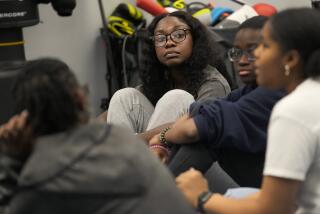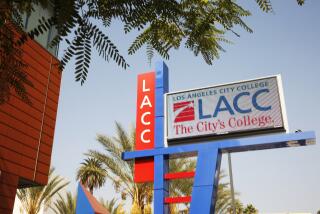Making a Classic Choice : At Thomas Aquinas College, Proclaimed One of the Nation’s Best Liberal Arts Schools, Students Study Only the Great Thinkers of Western Civilization
- Share via
SANTA PAULA — Heading into the winter break--with most college students preparing for final exams in accounting, English and computer skills--a small group of scholars grappled over the ethics of selling bread to a starving man.
Faces marked by knit brows and puzzled expressions, they struggled to grasp ancient ideas, proposed by the Greek philosopher Aristotle, on the morals of exchange and barter.
One question begot another. How does one determine the fair price of an object?
Is it based on demand? If so, one student argued, then why is air free?
Or is it based on need? If it is, another student shot back, wouldn’t art be worthless?
For some people, the questions may border on the esoteric. But to the 232 students at Thomas Aquinas College, they are part of the daily stock of education.
Hidden in the mountains of Los Padres National Forest, halfway between Ojai and Santa Paula, the college is unknown to many. Some simply know the cluster of low-lying modular buildings as the starting point for the popular three-mile hike to the Devil’s Punchbowl.
But as hikers pass and other students pursue more conventional studies, the scholars at Thomas Aquinas College are getting a different type of education, one that is attracting an increasing number of students and boosting the college’s reputation as one of the nation’s best small, private liberal arts colleges.
The college is one of only a handful of colleges nationwide that offers a liberal arts degree by studying the classics of Western civilization from 2,500 B.C. to the early 20th century.
Although few schools offer so-called Great Books programs, Thomas Aquinas is one of only two colleges in the nation devoted solely to a study of the masters.
At Thomas Aquinas, students learn physics from Einstein, calculus from Newton, evolution from Darwin and genetics from Mendel. They study music composition from Mozart, political science from Locke and examine Freud’s view of the psyche.
“Students are here to spend four years developing their intelligence and honing their minds,” said Thomas Dillon, the school’s president. “They read the authors that have shaped [this] world.”
Although reviewed annually, the school’s curriculum has changed little since it was founded 25 years ago. Most recently, the writings of Francois Viete, whose applications of algebra to geometry formed the basis of Descartes’ mathematical theorems, were added to make studying the latter mathematician’s ideas easier.
Meanwhile, after the fall of the Soviet Union, some of Karl Marx’s more detailed writings on the workings of the socialist state were dropped. And, at the request of an instructor who argued that Jane Austen was the best English prose stylist of all time, the author’s “Emma” was added to the reading list, making Austen the only female Great Books author at the school.
At Thomas Aquinas, students read only these classics. There are no lectures and no note-taking. Classes, one-hour tutorials and labs in the mornings and longer seminars at night consist of discussions propelled by students’ questions.
Classroom exchanges often spill over into the commons--a neo-Spanish building where students and instructors share their meals side by side--or to the drab modular dormitories where students live segregated by sex.
Students rarely leave campus. Except for school-sponsored social events, a film or dance, most evenings are spent studying.
“You may only have one or two pages to read,” junior Rory Nugent said. “But it’s Aristotle, so it takes you an hour or two to figure it out.”
The point to all this rigorous study, the students say, is not necessarily to graduate with a degree that allows them to be a banker, a doctor or a lawyer. Instead, they say, such study helps them become better thinkers and, as a result, better human beings.
“In high school I saw that you could come to know something and that education was far more than just practical,” said senior Andrea Sassman, who is from Idaho. “There was education appropriate to a human being, so you are better able to think and better able to act.”
Unlike many Great Books programs, Thomas Aquinas College instructors tell students that eternal truths can be pinned down through reason.
“Here, you all figure the truth out for yourselves,” freshman Tracy Colton said. “And when you do discover it, it is so rewarding.”
Unabashedly Roman Catholic, the school’s bottom line is that truth is objective and can be discovered in the words of time-tested masters, particularly St. Thomas Aquinas. The 12th century Italian saint is considered the Roman Catholic Church’s most enlightened teacher, philosopher and theologian.
“When you are serious about your faith, you go ahead and proclaim it,” Dillon said. “We are serious. We think God has revealed himself.”
Although the school welcomes students of all faiths, 91% of its student body is Catholic and most attend at least one of the three daily Masses in the school’s chapel.
Signs of the school’s religious bent are obvious. With its white walls and gray institutional carpeting, St. Augustine Hall, where most classes are taught, is largely unadorned except for the small gold crucifixes that hang above each chalkboard.
Crosses hang from necks and bedroom walls. Classes usually open with a prayer. And freshmen are required to read the Bible from Genesis to Revelation.
*
Although close to their faith, most students rail against being stereotyped as overly pious and intolerant, citing the school’s non-Catholics--a group that currently includes at least one atheist--as proof of their acceptance of other faiths.
Each year, about half of the non-Catholics convert. Adam Gardiner, 28, a former forklift driver at a large discount store in Los Angeles, is one of them.
The former punk rocker once led a life that revolved around “going to clubs and drinking a lot.” Then he was introduced to Thomas Aquinas College by a friend.
After discovering for himself “the eternal truths,” Gardiner said he saw “a whole new dimension of life that made life more valuable.”
At the end of his freshman year, he converted.
Others peaceably maintain their faith throughout the program. After graduating from high school in Idaho, Sassman and senior Ben Loop, who are engaged, spent one year in a Great Books program at Thomas Moore College in New Hampshire before deciding to transfer to a full-scale Great Books school.
As Protestants, they first considered the secular St. John’s College in Maryland, which in 1937 became the first school to base its curriculum exclusively on the Great Books and served as a model for Thomas Aquinas College.
But they chose Thomas Aquinas College instead. In spite of its religious affiliation, they valued the school’s stance that truth can be obtained through reason.
“At St. John’s, it was as if they were embarrassed to say, ‘You can know something.’ Everything seemed to be futile,” Loop said. “But here I felt as if they were saying this is a worthwhile pursuit and you can come to know something.”
Although they have felt some pressure to convert and believe that Catholics benefit more fully from the program, both say Thomas Aquinas College still offers the best Great Books education available.
Like most students, Catholic or not, Sassman and Loop say they are at the school primarily for a life ordered around studying.
That means school-mandated 11 p.m. curfews on weekdays, 1 a.m. on weekends and automatic expulsions for bringing alcohol or drugs on campus. In class, students must address their peers as Mr. and Miss.
Then there is the no-jeans dress code. Women must wear skirts or dresses to class and men must wear collared shirts and slacks.
Although some students have trouble adjusting to the strict rules, most welcome them.
“Education is really important to [us],” said Jeanne Chirdon, a freshman from Ohio. “People aren’t trying to get by the easy way so they can party all of the time. People here really care about the truth.”
About 60% of the students graduate from Thomas Aquinas. About half go on to graduate studies. Eleven percent of the school’s 567 graduates are following religious vocations.
“They are at ease with a broad range of subjects,” wrote Charles E. Rice, a professor at Notre Dame Law School, in a letter to the college. “I am convinced their ability to reason is incomparably better than what I have seen in even the superior students from any other colleges of which I know.”
At an annual tuition of $13,900, Barron’s in 1994 listed Thomas Aquinas College among its 300 best buys in college education. The National Review college guide in 1993 listed it as one of America’s top liberal arts schools. And Money magazine this year ranked it 12th on a list of 15 of the best colleges for the money in the West.
Although 34 of the students currently enrolled come from foreign countries--ranging from Ghana to Canada--very few U.S.-born minorities attend the school. Currently, the student body includes two blacks and 16 Latinos.
Those numbers, combined with the school’s selective reading list, have led some critics to denounce it as elitist.
But Thomas Aquinas College administrators say such notions of multiculturalism threaten their autonomy and the diversity of programs offered at the college level. As proof of their conviction, they led a battle last year against a regional accrediting authority trying to hold colleges accountable for fostering cultural diversity in their curriculum and student and faculty bodies.
Despite its opposition, Thomas Aquinas was praised by the accreditation committee for its high academic standards. In 1993, the committee extended the school’s accreditation for eight more years.
Director of Admissions Tom Susanka said it is difficult to attract minorities to Thomas Aquinas College.
“We want any student who would come here at all,” he said. “But it is difficult. . . . When you say why don’t you come here where you can read Tolstoy and argue about 2nd century astronomy, people are unsure at best.”
As for diversifying its curriculum, students, faculty and administrators see little to be concerned about.
“We kind of think of it as a nonissue,” said Richard D. Ferrier, an administrator. “There was only one Newton and he happened to be male. And if the next breakthrough is by a female biologist, we’ll read it.”
More to Read
Sign up for Essential California
The most important California stories and recommendations in your inbox every morning.
You may occasionally receive promotional content from the Los Angeles Times.










